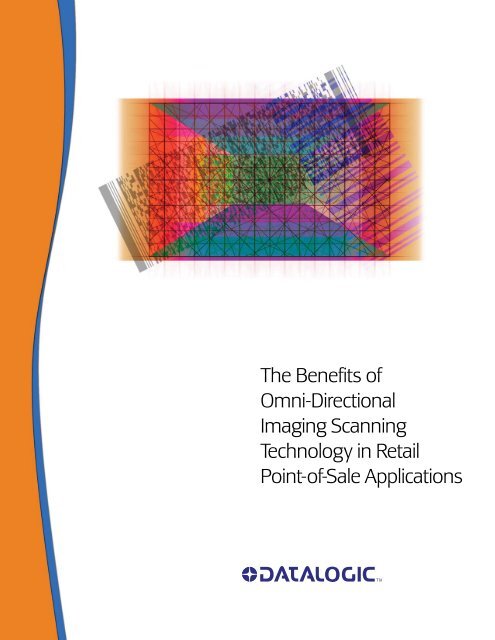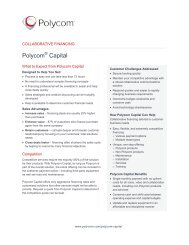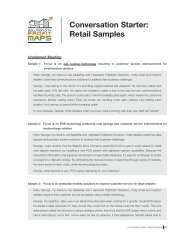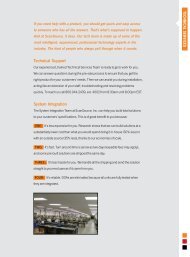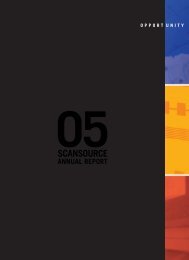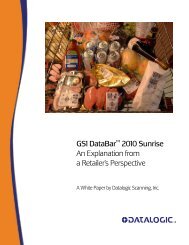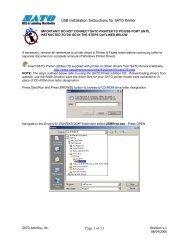The Benefits of Omni-Directional Imaging Scanning ... - ScanSource
The Benefits of Omni-Directional Imaging Scanning ... - ScanSource
The Benefits of Omni-Directional Imaging Scanning ... - ScanSource
Create successful ePaper yourself
Turn your PDF publications into a flip-book with our unique Google optimized e-Paper software.
<strong>The</strong> <strong>Benefits</strong> <strong>of</strong><strong>Omni</strong>-<strong>Directional</strong><strong>Imaging</strong> <strong>Scanning</strong>Technology in RetailPoint-<strong>of</strong>-Sale Applications
Contents<strong>Benefits</strong> <strong>of</strong> <strong>Omni</strong>-<strong>Directional</strong> <strong>Imaging</strong> <strong>Scanning</strong> Technology in RetailPoint-<strong>of</strong>-Sale ApplicationsIntroduction.. . . . . . . . . . . . . . . . . . . . . . . . . . . . . . . . . . . . . . . . . . . . . . . . . . . . . . . . . . . . . . . . . . . . . . . . . . . . . . . . . . . . . . . . . . . . . . . . . . . . . . 1Current Technologies.. . . . . . . . . . . . . . . . . . . . . . . . . . . . . . . . . . . . . . . . . . . . . . . . . . . . . . . . . . . . . . . . . . . . . . . . . . . . . . . . . . . . . . . . . . . . 1Presentation Scanners. . . . . . . . . . . . . . . . . . . . . . . . . . . . . . . . . . . . . . . . . . . . . . . . . . . . . . . . . . . . . . . . . . . . . . . . . . . . . . . . . . . . . . . . . . 2<strong>The</strong> Concept behind Datalogic’s <strong>Omni</strong>-<strong>Directional</strong> <strong>Imaging</strong> Scanners . . . . . . . . . . . . . . . . . . . . . . . . . . . . . . . . . . . . . . . . .3Virtual Scan Lines.. . . . . . . . . . . . . . . . . . . . . . . . . . . . . . . . . . . . . . . . . . . . . . . . . . . . . . . . . . . . . . . . . . . . . . . . . . . . . . . . . . . . . . . . . . . . . . . 3Presentation Scanner Use Environments. . . . . . . . . . . . . . . . . . . . . . . . . . . . . . . . . . . . . . . . . . . . . . . . . . . . . . . . . . . . . . . . . . . . . . 4Summary. . . . . . . . . . . . . . . . . . . . . . . . . . . . . . . . . . . . . . . . . . . . . . . . . . . . . . . . . . . . . . . . . . . . . . . . . . . . . . . . . . . . . . . . . . . . . . . . . . . . . . . . 5About Datalogic <strong>Scanning</strong>, Inc... . . . . . . . . . . . . . . . . . . . . . . . . . . . . . . . . . . . . . . . . . . . . . . . . . . . . . . . . . . . . . . . . . . . . . . . . . . . . . . . . 6
Copyright © Datalogic <strong>Scanning</strong>, Inc. 2006-2007. All rights reserved. • Protected to the fullest extent under U.S. and international laws.Copying, or altering <strong>of</strong> this document is prohibited without express written consent from Datalogic <strong>Scanning</strong>, Inc.Datalogic <strong>Scanning</strong>, Inc. <strong>of</strong> Eugene, Oregon, USA is ISO registered by NQA.Magellan, QuickScan, and the Datalogic logo are registered trademarks <strong>of</strong> Datalogic <strong>Scanning</strong>, Inc.All other brand and product names are trademarks <strong>of</strong> their respective owners.Information on Datalogic products and services, and electronic, downloadable versions <strong>of</strong> this document are located on the Datalogic website: www.datalogic.com. • Please contact your Datalogic <strong>Scanning</strong>, Inc. Representative.Reasonable measures were taken to ensure that the information provided is complete and accurate at the time <strong>of</strong> publication. However,Datalogic reserves the right to change any product specification at any time without prior notice. Please visit our web site at: www.datalogic.com for the most up-to-date version. Reasonable measures were taken to ensure that information taken from other sources wascorrect at the time <strong>of</strong> publication. Datalogic <strong>Scanning</strong>, Inc. is not responsible for errors <strong>of</strong> omission or inaccuracies, as material becomesdated shortly following publication.
<strong>Benefits</strong> <strong>of</strong> <strong>Omni</strong>-<strong>Directional</strong><strong>Imaging</strong> <strong>Scanning</strong> Technology inRetail Point-<strong>of</strong>-Sale ApplicationsIntroductionFew developments have affected the enterprise’s supply chain as the ability to automatically capture bar code data.This is especially true at the point-<strong>of</strong>-sale in the retail industry. Capturing and analyzing bar code data has enabledsignificant operational efficiencies in ordering and inventory, merchandising, checkout productivity and customerservice. <strong>The</strong> retail checkout was forever changed in 1974 when the first bar code was scanned at a grocery storein Troy, Ohio (U.S.A.) with a scanner manufactured by Datalogic <strong>Scanning</strong>, Inc. Over the past three decades manychanges and advances have been made in scanning technology that have increased scanning speed while alsoimproving accuracy and usability.Current TechnologiesHistorically, there have been essentially two categories <strong>of</strong>technologies employed to read bar codes at the retail checkout:lasers and imagers. Laser bar code scanners employ either a singleor multiple visible light lasers and either move the laser beam inways to create an individual scan line or reflect the laser beamsfrom strategically placed mirrors to make various “patterns”. <strong>The</strong>objective in either case is to create a scan line or lines that will spanFigure 1: QuickScanthe width <strong>of</strong> the bar code and transmit the reflected light variances® QS6500BT Handheld Scannerfrom the bars and spaces <strong>of</strong> the bar code to a light collection device that the scanner then decodes and transmits tothe host terminal. One advantage <strong>of</strong> laser scanners is their ability to capture bar codes that move through the scanzone at high speeds, which can approach 100 inches per second (IPS).Because <strong>of</strong> this capability, laser scanners, in certainconfigurations, are especially suited to high volume checkoutslike those found in supermarkets. <strong>The</strong>re are three basic types<strong>of</strong> laser scanners: single line, used primarily in handheldscanners; single plane using a pattern <strong>of</strong> scan lines that arecreated by reflecting the laser from a series <strong>of</strong> mirrors; and bioptic,essentially two single plane scanners combined to formboth horizontal and vertical planes. Bi-optics and single planeFigure 2: Magellan ® 8500 Bi-optic Stationary Scanner scanners can read part <strong>of</strong> a bar code label with one scan line<strong>The</strong> <strong>Benefits</strong> <strong>of</strong> <strong>Omni</strong>-<strong>Directional</strong> <strong>Imaging</strong> <strong>Scanning</strong> Technology in Retail Point-<strong>of</strong>-Sale ApplicationsPage –
(or one plane) and part <strong>of</strong> the label with anotherand combine or “stitch” the label fragmentstogether to decode the entire label.<strong>Imaging</strong> scanners operate somewhat like acamera. <strong>The</strong>y capture a “picture” <strong>of</strong> the label,and unlike laser scanners have no movingparts (motors or mirrors). Imagers are primarilyavailable in two types. <strong>The</strong> first type, linearimagers, capture a “picture” using a single row<strong>of</strong> pixels and then use a processor to decodethe label “picture” and transmit the decoded barFigure 3: Magellan ® 1000i Presentation Scannercode data to the host terminal. Linear imagersmust be aligned along the perpendicular axis <strong>of</strong>the bar code, a characteristic that has mostly limited their use to handheld scanners.Array imagers, the second type, are even more like a camera. <strong>The</strong> array imager captures a picture <strong>of</strong> the entire barcode, in any orientation, and its processor re-orients the data picture and decodes the label. Array imagers usuallyhave the additional ability to decode 2D bar codes. Array imagers are typically more expensive than linear imagersand are primarily used in handheld scanners. Like cameras, imagers need a light source to illuminate the bar code.<strong>The</strong>se light sources are usually Light Emitting Diodes (LED’s). Also, like cameras, imagers are more susceptible tomotion (which can blur the image) than lasers are. <strong>The</strong>refore, imagers have traditionally been used in handheldscanners where the scanner is brought to the bar code to minimize relative motion between the bar code and thescanner.Presentation ScannersIn addition to handheld, single plane, and bi-optic scanners,there is another type: the presentation scanner. Presentationscanners are typically used in retail checkout environments thathave a relatively small number <strong>of</strong> items per transaction such asconvenience stores, drug stores, and certain specialty stores.<strong>The</strong> distinguishing characteristic <strong>of</strong> these environments aretransactions that are made up <strong>of</strong> mostly small to medium-sizeditems where the most operationally efficient method <strong>of</strong> scanningis to bring (or present) the item to the scanner. It is also requiredFigure 4: Magellan ® 1400i Presentation Scannerin these environments that the operator need not orient the barcode to align with the scan pattern, hence the term, omni-directional scanner.Page – Datalogic <strong>Scanning</strong>, Inc. White Paper
Because these environments occasionally sell large, heavy, or bulky items, it is necessary that the presentationscanner also have a size and shape that is ergonomically capable <strong>of</strong> being picked up and used as a handheldscanner.<strong>The</strong> Concept behind Datalogic’s <strong>Omni</strong>-<strong>Directional</strong> <strong>Imaging</strong>Scanners<strong>The</strong> Datalogic Magellan ® 1000i and Magellan ® 1400i scanners are the market’s first omni-directional imagingpresentation scanners. Before the technology behind these innovative scanners became available, the ability toscan a bar code in any orientation was limited to either a laser using a series <strong>of</strong> mirrors that created a pattern <strong>of</strong>intersecting scan lines or an array imager that captured a picture <strong>of</strong> the entire bar code.<strong>The</strong> Magellan presentation scanners have all the benefits <strong>of</strong> a laser-based presentation scanner without the movingparts required to create a pattern <strong>of</strong> scan lines. Essentially the Magellan presentation scanners take a “picture” <strong>of</strong>the label with a digital scan pattern having lines that are one pixel wide. This vastly reduces the processing requiredversus that needed to decode a full two-dimensional image. Imagine looking at an object through a picket fence.Without seeing the entire object your mind is still able to recognize and identify the object.Virtual Scan Lines<strong>The</strong> Magellan 1000i and Magellan 1400i scanners usethese virtual scan lines, which accurately, aren’t lines at allbut “pictures” taken along the lines. <strong>The</strong> combined pattern<strong>of</strong> these virtual scan lines is actually formed by cyclingthrough four differently positioned pattern layouts every100 milliseconds. A single pattern from the Magellan 1000iis depicted in Figure 5. <strong>The</strong> complete composite pattern forthe Magellan 1000i, which scans approximately ten times asecond is depicted in Figure 6.Figure 5: <strong>Omni</strong>-<strong>Directional</strong> <strong>Imaging</strong> Pattern OneAs soon as the Magellan omni-directional presentationscanners have captured enough <strong>of</strong> the bar code, they decodeand send the data to the host terminal. That recognition mayoccur during the first, second, third, or fourth pattern. Barcodes are viewed using a lens, designed for extended depth<strong>of</strong>-fieldand efficient light collection.Figure 6: Combined <strong>Omni</strong>-<strong>Directional</strong> <strong>Imaging</strong> Pattern<strong>The</strong> <strong>Benefits</strong> <strong>of</strong> <strong>Omni</strong>-<strong>Directional</strong> <strong>Imaging</strong> <strong>Scanning</strong> Technology in Retail Point-<strong>of</strong>-Sale ApplicationsPage –
Figure 7: <strong>Omni</strong>-<strong>Directional</strong> POS PatternIllumination, required for imagers and somewhat akin to a flash fora camera, is provided by using an array <strong>of</strong> LED’s. In order to read barcodes at high sweep speeds, the LED’s are pulsed once per frameduring the imager’s exposure time. <strong>The</strong> LED’s are pulsed at a highfrequency, primarily to reduce motion blur, but also to avoid anyflicker effect that could be visible to the human eye. <strong>The</strong> capturedimage is then enhanced in the processor along the virtual scan linesand decoded.What does this mean for the user? Because <strong>of</strong> this dense virtual scan line pattern, the Magellan presentation cannershave outstanding speed and first-pass read rates which improve productivity and make it easy to scan in anyorientation. Because <strong>of</strong> the two different types <strong>of</strong> pulsed illumination, these scanners have a closely defined depth<strong>of</strong>-fieldand read very well throughout their range. Unlike traditional imagers, the Magellan presentation scannersare also very good at reading items swept through their scan volume which allows them to adapt to the user’s scantechnique; either sweep, presentation, or a combination. Unlike traditional lasers, these omni-directional scannersaccomplish all this without any moving parts which renders them extremely durable and reliable.Presentation Scanner Use Environments<strong>The</strong> Magellan 1000i and Magellan 1400i scanners are designed for convenience stores, drug stores, specialty storesand other medium volume checkout environments. <strong>The</strong> Magellan presentation scanners’ solid-state constructionincreases reliability while the ultra-small size frees up valuable counter selling space.Common requirements and constraints <strong>of</strong> these retail checkout use environments include:• Relatively small counter space, which necessitates minimizing the scanner’s footprint; both to save room foritems the consumer places on the counter and to free up additional revenue producing space for counterdisplays <strong>of</strong> higher margin items. Magellan presentation scanners have a very small size and footprint,allowing optimum placement on the checkout counter whilemaximizing available high margin selling space• Relatively low number <strong>of</strong> items per transaction, wherea single plane or presentation type scanner is adequateto maintain acceptable checkout productivity. Magellanpresentation scanners are performance-optimized to be veryproductive in medium volume checkout environments byenabling omni-directional scanning while maintaining thebalance between cost and value.• Primarily smaller-sized items that lend themselves to bepicked up by the cashier and either “presented” to or sweptpast the scanner. Magellan presentation scanners matchcashier scanning styles by allowing them to either “present”items or “sweep” items past the scanner’s window.Figure 8: Magellan ® 1400i Presentation ScannerPage – Datalogic <strong>Scanning</strong>, Inc. White Paper
• Occasional larger items that are either too heavy or too cumbersome for the cashier to orient towards apresentation or single plane scanner. While excelling in presentation mode, Magellan presentation scanners—because <strong>of</strong> their small size, light weight, and rubberized grip area — enables the checker to easily usethem in the handheld mode.• A relatively high incidence <strong>of</strong> hard-to-read bar codes is caused by very small bar code labels, crinkled orfolded codes, items from smaller manufacturers, or in-store printed systems that may lack normal labelquality. Decoding s<strong>of</strong>tware in the Magellan presentation scanners allows fast and reliable reading <strong>of</strong> eventhe toughest bar codesSummary<strong>The</strong> Magellan presentation scanners incorporate omni-directional imaging technology that provides aggressiveperformance in a space saving design. <strong>The</strong>se scanners excel at capturing hard-to-read bar codes omni-directionallyand support both presentation and sweep scanning styles. <strong>The</strong>y also <strong>of</strong>fer an optional targeted scanning mode forscanning close proximity bar codes like those on a Price Look Up (PLU) list.Designed for “small-counter” retail environments, the Magellan 1000i and Magellan 1400i scanners incorporateseveral design wins for the user. <strong>The</strong> design objective was simple: improve checkout productivity while protectingthe customer’s investment by adding capabilities that would extend the typical life <strong>of</strong> the scanner. Datalogic hasdeveloped a bar code scanner with outstanding ergonomics especially when handheld use is required, and has anexcellent price-to-value ratio.Datalogic’s imaging technology has no moving parts, providing excellentreliability and durability. This technology has a significant s<strong>of</strong>tware componentthat makes adding features and enhancements much easier. Magellan 1000iand Magellan 1400i scanners have Datalogic’s multi-interface support built-in,allowing the user to select a new interface with a simple program parameterchange and a cable switch.<strong>The</strong> Magellan 1000i and Magellan 1400iomni-directional imaging presentationscanners provide an excellentperformance value with outstandingreliability in a small and ergonomic spacesavingpackage.Figure 9: Magellan ® 1000i Presentation Scanner with and without stand<strong>The</strong> <strong>Benefits</strong> <strong>of</strong> <strong>Omni</strong>-<strong>Directional</strong> <strong>Imaging</strong> <strong>Scanning</strong> Technology in Retail Point-<strong>of</strong>-Sale ApplicationsPage –
About Datalogic <strong>Scanning</strong>, Inc.Datalogic <strong>Scanning</strong>, Inc., an autonomous division <strong>of</strong> Datalogic S.p.A., is the recognized worldwide leader in retailfixed position scanners and hand-held scanners. Datalogic <strong>Scanning</strong> leads the market with its flexible, responsivecustomer service and <strong>of</strong>fers a broad array <strong>of</strong> technology, products, and services in the retail automation andautomated data-capture market. Datalogic <strong>Scanning</strong> products and services support multiple industries throughoutthe retail supply chain, distribution channel, manufacturing, government, healthcare, banking and finance sectors.Datalogic has developed a worldwide network <strong>of</strong>over 500 partners in over 40 countries, selectedand qualified to <strong>of</strong>fer the highest level <strong>of</strong> servicesand solutions in the industry. With a presencein over 100 countries, the headquarters, primarydevelopment, marketing, and major manufacturingfacilities for Datalogic <strong>Scanning</strong> are located inEugene, Oregon, USA, while sales and service<strong>of</strong>fices are located throughout the Americas,Europe, Asia, and the Pacific Rim.Figure 10: Magellan ® 1400i Presentation ScannerPage – Datalogic <strong>Scanning</strong>, Inc. White Paper
Datalogic <strong>Scanning</strong>, Inc.959 Terry StreetEugene OR 97402-9150 USATel: 800 695 5700 or 541 683 5700Fax: 541 345 7140www.datalogic.comscanning@datalogic.comDatalogic <strong>Scanning</strong>, Inc. Worldwide Sales and Service LocationsDATALOGIC SCANNING, INC.HEADQUARTERS (USA): ASIA PACIFIC: EMEA: LATIN AMERICA:Tel: 1-800-695-5700 or 1-541-683-5700 Australia: 61 2 9870 3200 France: 33 0 1 6486 7100 Latin America Headquarters:Fax: 541 345 7140 China - Beijing: 86-10-62111803 Germany: +49 (0)61 51/93 58 0 305-591-3222North American Sales China - Shanghai: 021-58360023 Italy: 39 039 629031 Brazil: 55 11 5507 7721Tel: 1-800-929-3221 or 1-330-463-5300, option 3 Hong Kong: 852 2 584 6210 Russia: 007 495 78 79 937 Mexico: 52 5663 3962Fax: 1-330-463-3533 India: 91 22 6450 4739 Spain: 34 91 746 28 60Japan: 81 3 3491 6761 United Kingdom: 44 0 1923 809500Singapore: 65 6435 1311R40-1008-US C 0207


